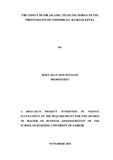| dc.description.abstract | The Islamic banking system has gained momentum worldwide. Islamic banking refers to
financial services that meet the requirements of the Shari’ah or Islamic law. Also called
Islamic finance or Islamic financial services, Islamic banking represents the practical
application of modern Banking concepts within the overall development of Islamic
Economics (Abdeen & Dale, 1984). The Shari’ah prohibits the payment of fees for the
renting of money (Riba or Interest) for specific terms, as well as investing in businesses that
provide goods or services considered contrary to its principles (Haraam) such as gambling,
pornography, pork or alcohol. Since its introduction in Kenya in 2007, rapid growth has been
seen in number of commercial banks offering Islamic financial services and efforts to
demystify Islamic banking and improve it. The main objective of this study was to evaluate
the effect of different Islamic financing modes on profitability of commercial banks in Kenya
over a period of six five years (2008-2013). Correlation analysis was carried out to
investigate the strength of the relationship between the dependent variable and independent
variables. Regression analysis was carried out to investigate the nature of the relationship
between the dependent and independent variables. Looking at the variables collectively, it’s
evident that there was a strong positive significant relationship between an Islamic banks
performance and different financing modes. From this we can conclude that an increase in
either of the variables of interest is associated with an increase in Islamic bank performance.
The ANOVA shows an F value of 3.776 and a P value < 0.05 indicating that the overall
regression model for the control variables is significant hence it has some explanatory value.
Hence, there is a significant relationship between return on assets and different financing
modes. At 95 percent confidence interval P–value (p<0.05) implying that the variables
combined do influence Islamic banks performance. In the full model constituting of
predictors and the control variables, Ijara had the most statistically significant coefficient as
indicated by the t-ratio of 2.353 (β=7.58E-10, t=2.353, p value =0.04). It is important to note
that all the available Islamic products available in Kenyan commercial banks had a positive
significant relation with the return on assets implying that the diversification and introduction
of more financing modes will enhance commercial banks performance offering Islamic
financial services. However, there is no multi-Collinearity between the different financing
modes. The study therefore recommends that more financing modes should be introduced and
pursued to increase uptake of Islamic financial services. Central Bank of Kenya should also
hasten the process of structuring regulations and markets for Islamic financial instruments
such as Sukuk since Islamic banks are locked out of treasury bills and bonds which are
considered non-compliant to Islamic banking and financing Shariah regulations. | en_US |

